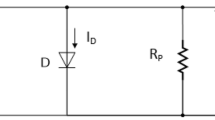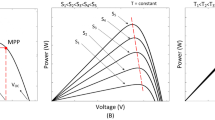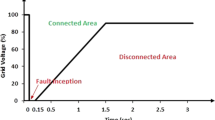Abstract
This paper presents a multiobjective maximum power point tracking (MPPT) control for photovoltaic (PV) system to guarantee both \(H_{2}\) optimal control and \(H_{\infty }\) model reference tracking performance simultaneously. First, the Takagi and Sugeno (T–S) fuzzy model is employed to describe the dynamic behavior of DC–DC boost converter. Then, based on this exact T–S fuzzy representation, multiobjective \(H_{2}/H_{\infty }\) MPPT controller is designed to minimize concurrently the \(H_{2}\) tracking error and \(H_{\infty }\) disturbance attenuation level for the PV system. A specified T–S reference model is constructed to provide the desired trajectory which must be tracked. An MPP searching algorithm is also added in the global MPPT structure to generate the optimal PV current which is considered as input control for the T–S reference model. Finally, simulation results are given to illustrate the optimal tracking performance of the proposed fuzzy controller even when rapidly changing climatic conditions.






Similar content being viewed by others
References
Abdessalem AK, Massoud AM, Ahmed S, Enjetti PN (2011) High-performance adaptive perturb and observe MPPT technique for photovoltaic based microgrids. IEEE Trans Power Electron 26:1010–1021
Alghuwainem SM (1992) Steadly state performance of DC motors supplied from photovoltaic generators with step-up converter. IEEE Trans Energy Convers 7:262–272
Bor SC, Shih JH (2015) Multiobjective tracking control design of T–S fuzzy systems: fuzzy Pareto optimal approach. Fuzzy and set systems. Accepted 18 June 2015
Besheer AH, Emara HM, Abdel Aziz MM (2006) An LMI approach to mixed \(H_{2}/H_{\infty }\) model following based fuzzy control for nonlinear dynamic system. IEEE Int Conf Syst Man Cybern 3:3103–3108
Chen BS, Zhang WH (2004) Stochastic \(H_{2}/H_{\infty }\) control with state-dependent noise. IEEE Trans Autom Control 49:45–57
Chen BS, Tseng CS, Uang HJ (2000) Mixed \(H_{2}/H_{\infty }\) fuzzy output feedback control design for nonlinear dynamic systems: an LMI approach. IEEE Trans Fuzzy Syst 8:249–265
Chiu CS (2010) T-S fuzzy maximum power tracking control of solar power generation systems. IEEE Trans Energy Convers 25:1123–1132
Chiu CS, Ouyang YL (2011) Robust maximum power tracking control of uncertain photovoltaic systems: a unified T-S fuzzy model-model based approach. IEEE Trans Control Syst Technol 19:1516–1526
Chong L, Wang QG, Lee TH (2006) Output tracking control for nonlinear via T-S fuzzy model approach. IEEE Trans Syst Cybern 36:451–457
Dahmane M, Bosche J, El-Hajjaji A, Davarifar M (2013) T-S Implementation of an MPPT Algorithm for Photovoltaic Conversion System Using Poles Placement and \(H_\infty \) Performances. In: Proceedings of the 3rd international conference on systems and control, Oct 29–31
de Brito MAG, Galotto L, Sampaio LP, de Azevedo e Melo G, Canesin CA (2013) Evaluation of the main MPPT techniques of photovoltaic applications. IEEE Trans Ind Electron 60:1156–1167
Esram T, Chapman PL (2007) Comparison of photovoltaic array maximum power point tracking techniques. IEEE Trans Energy Convers 22:439–449
Liu F, Duan S, Liu F, Liu B, Kang Y (2008) A variable step size INC MPPT method for PV systems. IEEE Trans Ind Electron 55:2622–2628
Lyden S, Haque ME (2015) Maximum power point tracking techniques for photovoltaic systems: a comprehensive review and comparative analysis. Renew Suitable Energy Rev 52:1504–1518
Mimouni F, Mansouri MN, Benghanem B, Annabi M (2004) Vectorial command of an asynchronous motor fed by a photovoltaic generator’. Renew Energy 29:433–442
Mohammed ASM, Hooman D, Ewald FF (2002) Theoretical and experimental analyses of photovoltaic systems with voltage-and current-based maximum power-point tracking. IEEE Trans Energy Convers 17:514–522
Nabulsi AA, Dhaouadi R (2012) Efficiency optimization of a DSP-based standalone PV system using fuzzy logic and dual-MPPT control. IEEE Trans Ind Inform 8:573–584
Salah CB, Ouali M (2011) Comparison of fuzzy logic and neural network in maximum power point tracker for PV systems. Electric Power Syst Res 81:43–50
Salas V, Olias E, Barrado A, Lazaro A (2006) Review of the maximum power point tracking algorithms for stand-alone photovoltaic systems. Solar Energy Mater Solar Cells 90:1555–1578
Sera D, Mathe I, Kerekes T, Spataru SV, Teodorescu R (2013) On the perturb-and-observe and incremental conductance MPPT methods for PV system. IEEE J Photovolt 3:1070–1078
Subudhi B, Pradhan R (2013) A comparative study on maximum power point tracking techniques for photovoltaic power systems. IEEE Trans Sustain Energy 4:89–98
Tseng CS, Bor SC, Uang HJ (2001) Fuzzy tracking control design for non linear dynamic system via TS fuzzy model. IEEE Trans Fuzzy Syst 9:381–392
Wang H, Tanaka K, Griffin M (1996) An approach to fuzzy control of nonlinear systems: stability and design issues. IEEE Trans Fuzzy Syst 4:14–23
Zayani H, Allouche M, Kharrat M, Chaabane M (2015) T-S fuzzy maximum power point tracking control of photovoltaic conversion system. In: 16th international conference on sciences and techniques of automatic control & computer engineering, Dec 21–23, Monastir, Tunisia
Zhang LQ, Huang B, Lam J (2003) LMI synthesis of \(H_{2}\) and mixed \(H_{2}/H_{\infty }\) controllers for singular systems. IEEE Trans Circuits Syst II Analog Digit Signal Process 50:615–626
Author information
Authors and Affiliations
Corresponding author
Ethics declarations
Conflict of interest
The authors declare that they have no conflict of interest.
Human participants and/or animals
This article does not contain any studies with human participants performed by any of the authors.
Additional information
Communicated by A. Di Nola.
Appendix
Rights and permissions
About this article
Cite this article
Allouche, M., Dahech, K. & Chaabane, M. Multiobjective maximum power tracking control of photovoltaic systems: T-S fuzzy model-based approach. Soft Comput 22, 2121–2132 (2018). https://doi.org/10.1007/s00500-017-2691-7
Published:
Issue Date:
DOI: https://doi.org/10.1007/s00500-017-2691-7




